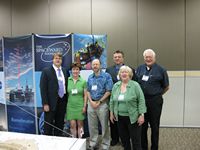 Once again, all together now;
Once again, all together now;
Happy birthday to you!
Happy birthday to you!
Happy birthday dear Space Elevator Blog!
Happy birthday to you!
Yes, I know it’s April Fools day, but again this is no joke – three years ago today, I started this blog. It’s been yet another exciting year. In keeping with my tradition of writing an ‘anniversary post’ (first year summary and second year summary), the following is a list of, IMHO, the more significant happenings in the past 12 months that I was privileged to cover:
The highlights for this past year include:
 The creation of the International Space Elevator Consortium (ISEC). This is the culmination of efforts by most of the ‘leading luminaries’ in the Space Elevator community to create an organization dedicated to actually getting a Space Elevator built. All of the existing Space Elevator organizations that I know about are part of this effort; the Spaceward Foundation, EuroSpaceward, the Japan Space Elevator Association, the Space Elevator Reference, the Space Elevator Wiki and my own Space Elevator Blog. In addition, other individuals who have had a long history within the Space Elevator effort have also joined in this effort. I am very honored to be the President of this organization and pledge to do whatever I can to make a Space Elevator happen within my lifetime.
The creation of the International Space Elevator Consortium (ISEC). This is the culmination of efforts by most of the ‘leading luminaries’ in the Space Elevator community to create an organization dedicated to actually getting a Space Elevator built. All of the existing Space Elevator organizations that I know about are part of this effort; the Spaceward Foundation, EuroSpaceward, the Japan Space Elevator Association, the Space Elevator Reference, the Space Elevator Wiki and my own Space Elevator Blog. In addition, other individuals who have had a long history within the Space Elevator effort have also joined in this effort. I am very honored to be the President of this organization and pledge to do whatever I can to make a Space Elevator happen within my lifetime.
 Attending and blogging on the Space Elevator Conference in Redmond, Washington. The Space Engineering and Science Institute did an outstanding job in organizing this conference. The arrangements, facilities and speakers were first-rate. I truly enjoyed all of the presentations I heard and also presented my own paper on who, IMHO, might be the first entity to actually create a Space Elevator.
Attending and blogging on the Space Elevator Conference in Redmond, Washington. The Space Engineering and Science Institute did an outstanding job in organizing this conference. The arrangements, facilities and speakers were first-rate. I truly enjoyed all of the presentations I heard and also presented my own paper on who, IMHO, might be the first entity to actually create a Space Elevator.
 Watching the traffic at this site continue to grow. This post is number 1,172 for this blog so I’m averaging nearly 400 posts per year. In it’s first year, the Space Elevator blog had approximately 28,000 hits. In it’s second year, this blog had about 68,000 hits. In this third year, we’ve had nearly 80,000 hits. While the growth rate looks like it has slowed, this is actually not the case – the average daily traffic has increased significantly. In the blog’s first and second years, traffic spiked during my coverage of the Space Elevator Games. I put up many posts during the Games and nearly 40% of the website hits in year 1 and year 2 were generated during that 10-12 day period. Even though there were no Space Elevator Games in this past 12 months, traffic at this site still increased over 15%. I fully expect our traffic numbers to double in the coming year with a) coverage of the Space Elevator games and b) coverage of the activity by the International Space Elevator Consortium (ISEC).
Watching the traffic at this site continue to grow. This post is number 1,172 for this blog so I’m averaging nearly 400 posts per year. In it’s first year, the Space Elevator blog had approximately 28,000 hits. In it’s second year, this blog had about 68,000 hits. In this third year, we’ve had nearly 80,000 hits. While the growth rate looks like it has slowed, this is actually not the case – the average daily traffic has increased significantly. In the blog’s first and second years, traffic spiked during my coverage of the Space Elevator Games. I put up many posts during the Games and nearly 40% of the website hits in year 1 and year 2 were generated during that 10-12 day period. Even though there were no Space Elevator Games in this past 12 months, traffic at this site still increased over 15%. I fully expect our traffic numbers to double in the coming year with a) coverage of the Space Elevator games and b) coverage of the activity by the International Space Elevator Consortium (ISEC).

 The release of a paper by Ben Shelef, CEO of the Spaceward Foundation entitled “The Space Elevator Feasability Condition“. This paper represents, IMHO, the first serious review of what it will take to build a Space Elevator since the Edwards-Westling Space Elevator book. In his paper, Ben argues that a tether as weak as 25-30 MYuris may be strong enough to build a useful Space Elevator tether. He discusses the various parameters which make up his calculations and shows how they relate to each other. Reading and understanding this document should be a requirement for anyone who is interested in Space Elevators.
The release of a paper by Ben Shelef, CEO of the Spaceward Foundation entitled “The Space Elevator Feasability Condition“. This paper represents, IMHO, the first serious review of what it will take to build a Space Elevator since the Edwards-Westling Space Elevator book. In his paper, Ben argues that a tether as weak as 25-30 MYuris may be strong enough to build a useful Space Elevator tether. He discusses the various parameters which make up his calculations and shows how they relate to each other. Reading and understanding this document should be a requirement for anyone who is interested in Space Elevators.
And finally, getting a professional-looking masthead for this blog. I want to thank Susan Seichrist once again for doing an outstanding job with this.
 Other highlights occuring the past year the announcement of the first Japan Space Elevator Games, attending ISDC2008 and seeing Ben Shelef’s absolutely awesome model of a hypothetical Space Elevator Games held at Meteor Crater in Arizona, the captain of the Kansas City Space Pirates, Brian Turner, appearing on the Conan O’Brien show, the release of the Iron Man comic book where the chief protagonist, Tony Stark, successfully manages the construction of a Space Elevator, Dr. Who and his cohorts using a Space Elevator to help thwart the bad guys, acknowledging NASA’s 50th Anniversary, the release of Ropewalk, installing DSL for my Mother, and beer-pouring robots.
Other highlights occuring the past year the announcement of the first Japan Space Elevator Games, attending ISDC2008 and seeing Ben Shelef’s absolutely awesome model of a hypothetical Space Elevator Games held at Meteor Crater in Arizona, the captain of the Kansas City Space Pirates, Brian Turner, appearing on the Conan O’Brien show, the release of the Iron Man comic book where the chief protagonist, Tony Stark, successfully manages the construction of a Space Elevator, Dr. Who and his cohorts using a Space Elevator to help thwart the bad guys, acknowledging NASA’s 50th Anniversary, the release of Ropewalk, installing DSL for my Mother, and beer-pouring robots.
Downers for the year include my inability to attend either the EuroSpaceward conference or the Japan Space Elevator Association conference due to reasons which are beyond bizarre and the disappointment of Arthur C. Clarke’s last book, The Last Theorem (released posthumously).
So, what’s coming up this year? Well, first and foremost should be the Space Elevator Games. As you are reading this, I should be returning home from a trip to an ‘undisclosed location’ with Ben Shelef of the Spaceward Foundation (hosts of the Space Elevator Games), trying to finalize arrangements for the Games. Let’s hope we were successful. Also upcoming is the next Space Elevator Conference, scheduled for August 13-16 of this year. The inaugural Japan Space Elevator Games are scheduled for early August and I would expect either/both the Europeans and Japanese to have another Space Elevator Conference this year (which I really do want to attend?).
The International Space Elevator Consortium (ISEC) should become a serious force for pushing the idea of someone (anyone) building a Space Elevator. We have a lot riding on this organization and I encourage you to visit our website and JOIN us in helping make this game-changing idea a reality.
Stay tuned and, thanks again for reading!

Congrats Ted!! And thanks for all your hard work 🙂
Congratulations on reaching your third anniversary. I have made making a space elevator my life goal, as it is our best hope to get into space, and the only technologically known one. I am going to go into materials science to make a tether.
I have some ideas to bandy about. First, there are no space elevator forums! If you can, ask the ISEC to make a forum so laypeople can ask questions and get answers, or even make suggestions!
Second, one of the best uses of a space elevator would be to, at the geostationary orbit, build a ring spanning the orbit, looping around the planet. On the outer edge we can put solar panels and have lots and lots of electricity, both cheap and clean and plentiful.
Or, at the very least, the solar panels could power the climbers.
Thank you Andrew and hello David!
There is a Space Elevator forum at Yahoo Groups (space-elevator@yahoo-groups.com) and they are fairly active. Having ISEC create it’s own forum would be just duplicating what they’re doing now (though that may change in the future). If you have some concrete ideas about space elevator / space elevator technology, putting them in writing and submitting them to the forum is one place to start.
Regarding a space ‘ring’, this was an idea first proposed (as far as I know) by the late Arthur C. Clarke in his novel the Fountains of Paradise. It’s a magnificent idea and I hope that humanity can do it someday – but first we need a Space Elevator ?
Ted
Kudos to you also from Europe! You’ve done an excellent job regarding outreach on the space elevator endeavor in the past 3 years. We wish you the best of health in order to run this blog for at least another 30 years….in other words, until we hopefully experience the inauguration of the first SE! 🙂
It is self evident that the greater the gravity a body has the greater the challenges for finding; the construction method, the materials and the finance. Has no one thought that one of the smaller moons of the solar system or may be some of the larger asteroids would make the best candidates? The material would not have to be so exotic something like Kevlar, M5 or Spectra and the distances are shorter. Why would we want to build a space Elevator on an asteroid? To help to efficiently transport mined ice for fuel and metals / minerals to one of earths lagrange points where we will be constructing a space gas station and a space dockyard of course….